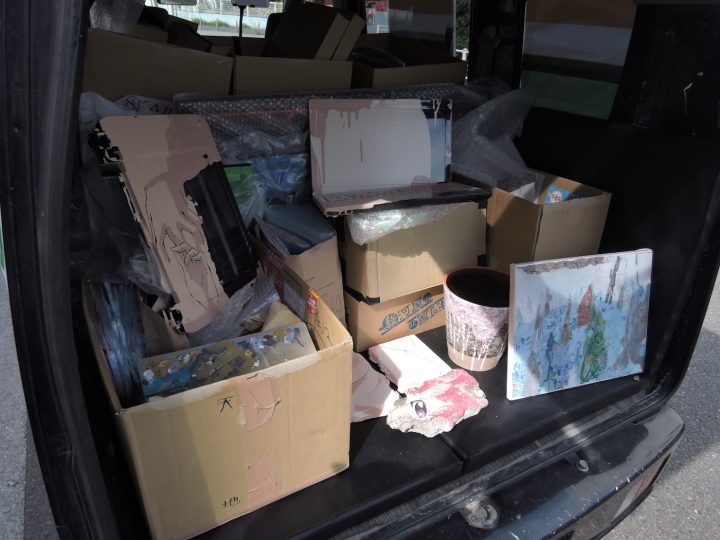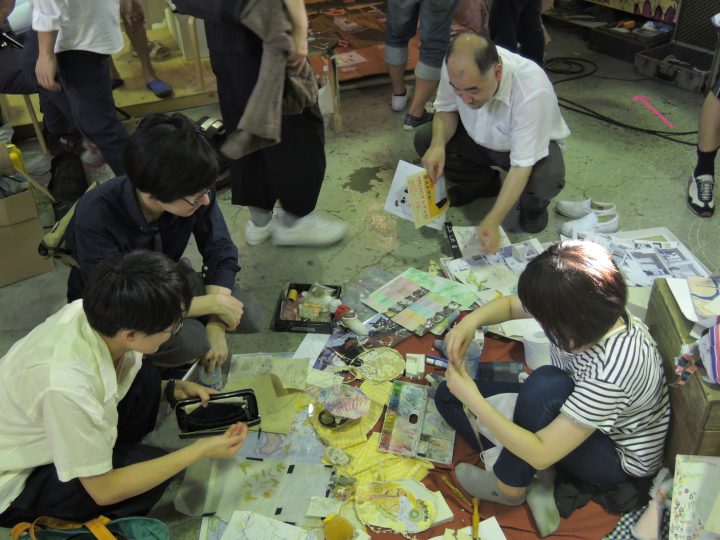Artists Stage a Contemporary Art “Black Market” in Tokyo
The event was organized to address an existential question that haunts Japanese artists: Is art possible when there’s only a limited domestic market to support it?
 Jeremy Woolsey2 days ago
The New BBC TV Series and What We Mean When We Say “Civilization”
Advertise on Hyperallergic with Nectar Ads
eBay for Charity and Brazilian Artist Ernesto Neto Partner to Support Fondation Beyeler’s Public Art ProjectChaos Lounge
Jeremy Woolsey2 days ago
The New BBC TV Series and What We Mean When We Say “Civilization”
Advertise on Hyperallergic with Nectar Ads
eBay for Charity and Brazilian Artist Ernesto Neto Partner to Support Fondation Beyeler’s Public Art ProjectChaos Lounge held the first
Contemporary Art Black Market at the “art factory”
BUCKLE KÔBÔ in Tokyo. The event was organized to address an existential question that haunts Japanese artists: Is art possible when there’s only a limited domestic market to support it? Indeed, Japan’s art market is severely underdeveloped in comparison to that of China, Britain, or the United States, representing about
one percent of the global market. Some say this stems from the failure of the government and powerful businesses to foster Japanese artists during the country’s economic “bubble” (1985–1992); instead, they preferred to purchase astronomically priced French Impressionist and Postimpressionist paintings. Now, young Japanese artists are looking for new ways to generate a market that don’t simply replicate the institutions of the global art world in a local context. This, according to
Yohei Kurose, who spearheaded Chaos Lounge, proves the underlying motive for the inaugural art black market:
A market won’t be born from people without magic, no matter how many of them gather together. Nor will it come from imitating already-established international exhibitions or art fairs.
First, there’s material that’s almost trash. Contemporary art starts here. Artists work magic on this trash, gathered from all over the place. Some of this magic fails, and some of it succeeds. What succeeds becomes treasure and what fails remains trash … a place where you can witness this [process] with your own eyes should be called a “market.”
Stall by SAIAKU (NAZE/takuya watanabe takuya/Yusho Morimoto) X MES (all photos taken by the author for Hyperallergic unless otherwise noted)
Chaos Lounge’s black market — essentially a bazaar with various artists peddling their work as pure commodities — holds particular significance in 2018 in light of the
Japanese Agency for Cultural Affairs’ proposed plan to create a division inside public museums — called the “Reading Museum” — to stimulate the domestic art market by holding art auctions. This plan has been disparaged by prominent contemporary artists such as
Koki Tanaka and Yoshytomo Nara, among others; in their view, the plan seems to indicate the government’s failure to recognize the decline of public museums in a global art world increasingly dominated by galleries, art fairs, biennials, and private museums. In contrast to the heavy-handed “Reading Museum,” Chaos Lounge’s black market represents the possibility of developing a domestic market through a decentralized, artist-run initiative.
The Chuo-Line Gallery’s outdoor stall
Walking up to KÔBÔ, located on the manmade industrial island of Keihinjima, the first thing I noticed was a black van parked outside, decorated by the artist
Tomotoshi with a megaphone (symbolic of right-wing demagogues) and a 7-Eleven logo. It parodied the political landscape in Japan where neo-nationalists and neoliberals increasingly resemble one another through their agreement on controversial issues, including
amending Japan’s pacifist constitution and the imposition of further austerity measures. Inside the van were a variety of found objects that had been made into unlikely canvases for paintings, ranging from broken laptops to a large chunk of concrete with an anime-style eye painted on it. The artist behind the eye painting,
Kensuke Sugimoto, told me that he was interested in portraying the way characters are increasingly consumed as fragmented pieces by repeating this process on rocks and other debris that he finds throughout the city (part of his Fragments of Scenery series). Subcultural interest in manga, anime, and gaming ran through much of the art in the black market.
Different works for sale by artists associated with the Chuo-Line Gallery
Upon ascending to the second floor, the center of the market, things turned frenetic. I was met with a sprawling array of original, readymade, and salvaged goods that I imagined, in a parallel universe, to be buried somewhere in Tokyo’s landfills. Here, individual artists as well as several art collectives, including the above-mentioned Chaos Lounge,
Parplume, and
SideCore, displayed their art, which included self-published books of art criticism, sketches of manga and anime characters, video games, certificates of achievement usually given to doctors, lawyers, and dentists, musical instruments, clothes, ancient books, a large Kurt Cobain painting, and more. The work heaped around me was an attempt at art, though as the site’s description warned, not all of it had been sublimed from waste to treasure. So, I was looking at a lot of trash and some art, but more importantly, a site of value-creation in real-time. The harsh bottom line for contemporary art — that what sells is art — was laid bare for all to see (though no one seemed to mind).
Second floor of the Black Market (photo courtesy Yohei Kurose)
The Artist KOURYOU at work
Perhaps the best example of this concept in action was a lottery-drawing contraption that resembles those found at summer festivals (matsuri) throughout Japan. This stand, run by the
Chuo-Line Gallery, was made of at least 100 plastic strands, threaded through a wooden frame, and connected to various artworks all sealed in bags. For 1,000 yen (roughly nine US dollars), you could pull one and receive your artwork by chance (as well as a QR code that, when scanned, displayed the location of the curious neoliberal/right-wing 7-Eleven car mentioned above as it drove around the area). At a deeper level, the lottery also referenced the origin of fine art in Japan — the
misemono(spectacle, show) and corresponding carnival-like atmosphere that characterized many viewers’ first interactions with oil paintings in the Meiji Period (1868–1912), before the austere, enlightenment-oriented institutions of the museum and trade exposition had fully taken root.
Chuo-Line Gallery’s “Art Lottery”
While artists can always leave Japan for more vital markets, there will inevitably be those who want to stay in the country and build something for themselves. Kurose, the leader of Chaos Lounge, was once a protégée of the superstar artist
Takashi Murakami. He parted ways with Murakami, however, over a fundamental difference in opinion over the best way to grow Japanese art. Murakami’s approach, best documented in his book
The Art Entrepreneurship Theory, is for Japanese artists to go abroad, learn the “rules” to the “game” of contemporary art in the West, compete, and win. While he created the art festival GEISAI in 2002, it seems more a platform for artists to gain access to the global market than a sustainable model for a local market. Kurose’s contemporary art black market represents his vision of an alternative to Murakami’s emphasis on expanding outwards. It is both a parody of a global art market dominated by price-manipulating fashion conglomerate magnates as well as a serious attempt to create a community of artists and buyers.
In an interview with Kurose, he shared that he plans to continue to hold the market periodically, and perhaps link up with other groups doing similar work internationally. This seems more attractive than the creation of more biennials or art fairs in Japan to court foreign capital. You can see value created here with your own eyes — it’s hanging in little bags in front of you. The trick will be figuring out how to maintain and grow it.
Chuo-Line Gallery’s “Art Lottery”
Artists Stage a Contemporary Art “Black Market” in Tokyo



 Jeremy Woolsey
Jeremy Woolsey





